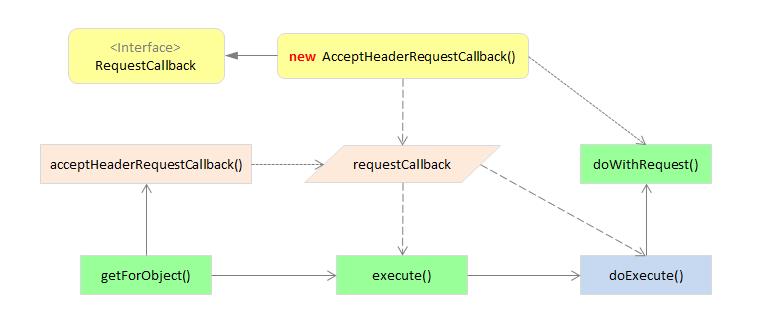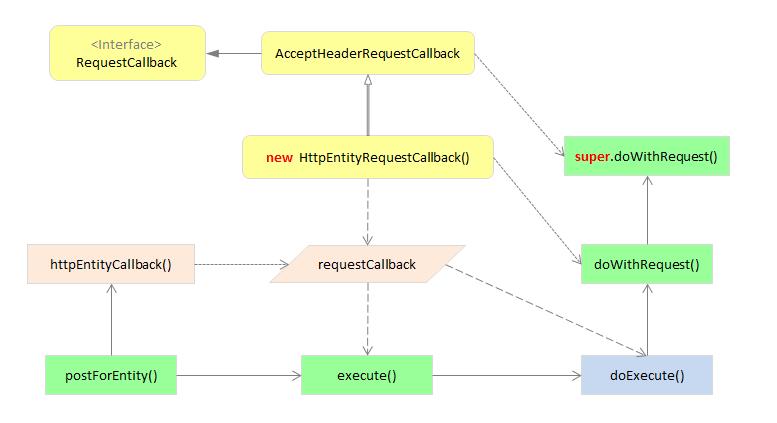Spring-webRestTemplate源码学习
Posted 安静的下雪天
tags:
篇首语:本文由小常识网(cha138.com)小编为大家整理,主要介绍了Spring-webRestTemplate源码学习相关的知识,希望对你有一定的参考价值。
2016-12-22 by 安静的下雪天 http://www.cnblogs.com/quiet-snowy-day/p/6210288.html
前言
在Web开发工作中,有一部分开发任务是不需要写web页面的。比如,本地服务在集成某些第三方的功能的时候(访问其他RESTful资源),通过转发URL请求到第三方服务,获取应答信息。这些应答信息不需要渲染到画面上,而是返回给客户端(APP或者其他web应用)。本地服务对于第三方服务来说是客户端;对于整体系统而言,就像是一个中转站。
这种开发内容除了业务逻辑,剩下的基本都是套路代码,而Spring从3.0版本开始,为我们提供了封装好的访问HTTP的模板代码RestTemplate。
这种开发内容除了业务逻辑,剩下的基本都是套路代码,而Spring从3.0版本开始,为我们提供了封装好的访问HTTP的模板代码RestTemplate。
RestTemplate 类说明

/**
* <strong>Spring\'s central class for synchronous client-side HTTP access.</strong>
* It simplifies communication with HTTP servers, and enforces RESTful principles.
* It handles HTTP connections, leaving application code to provide URLs
* (with possible template variables) and extract results.
*
* <p><strong>Note:</strong> by default the RestTemplate relies on standard JDK
* facilities to establish HTTP connections. You can switch to use a different
* HTTP library such as Apache HttpComponents, Netty, and OkHttp through the
* {@link #setRequestFactory} property.
*
* <p>The main entry points of this template are the methods named after the six main HTTP methods:
* <table>
* <tr><th>HTTP method</th><th>RestTemplate methods</th></tr>
* <tr><td>DELETE</td><td>{@link #delete}</td></tr>
* <tr><td>GET</td><td>{@link #getForObject}</td></tr>
* <tr><td></td><td>{@link #getForEntity}</td></tr>
* <tr><td>HEAD</td><td>{@link #headForHeaders}</td></tr>
* <tr><td>OPTIONS</td><td>{@link #optionsForAllow}</td></tr>
* <tr><td>POST</td><td>{@link #postForLocation}</td></tr>
* <tr><td></td><td>{@link #postForObject}</td></tr>
* <tr><td>PUT</td><td>{@link #put}</td></tr>
* <tr><td>any</td><td>{@link #exchange}</td></tr>
* <tr><td></td><td>{@link #execute}</td></tr> </table>
*
* <p>In addition the {@code exchange} and {@code execute} methods are generalized versions of
* the above methods and can be used to support additional, less frequent combinations (e.g.
* HTTP PATCH, HTTP PUT with response body, etc.). Note however that the underlying HTTP
* library used must also support the desired combination.
*
* <p>For each HTTP method there are three variants: two accept a URI template string
* and URI variables (array or map) while a third accepts a {@link URI}.
* Note that for URI templates it is assumed encoding is necessary, e.g.
* {@code restTemplate.getForObject("http://example.com/hotel list")} becomes
* {@code "http://example.com/hotel%20list"}. This also means if the URI template
* or URI variables are already encoded, double encoding will occur, e.g.
* {@code http://example.com/hotel%20list} becomes
* {@code http://example.com/hotel%2520list}). To avoid that use a {@code URI} method
* variant to provide (or re-use) a previously encoded URI. To prepare such an URI
* with full control over encoding, consider using
* {@link org.springframework.web.util.UriComponentsBuilder}.
*
* <p>Internally the template uses {@link HttpMessageConverter} instances to
* convert HTTP messages to and from POJOs. Converters for the main mime types
* are registered by default but you can also register additional converters
* via {@link #setMessageConverters}.
*
* <p>This template uses a
* {@link org.springframework.http.client.SimpleClientHttpRequestFactory} and a
* {@link DefaultResponseErrorHandler} as default strategies for creating HTTP
* connections or handling HTTP errors, respectively. These defaults can be overridden
* through {@link #setRequestFactory} and {@link #setErrorHandler} respectively.
*
* @author Arjen Poutsma
* @author Brian Clozel
* @author Roy Clarkson
* @author Juergen Hoeller
* @since 3.0
* @see HttpMessageConverter
* @see RequestCallback
* @see ResponseExtractor
* @see ResponseErrorHandler
* @see AsyncRestTemplate
*/
尝试翻译如下:
RestTemplate是 Spring中客户端同步访问HTTP的核心类。它简化了与HTTP服务器的通信,执行RESTful原则。
它能处理HTTP链接,委托应用程序代码(使用合适的模板变量)来装配URL,并提取应答信息。
注意:默认情况下,RestTemplate依赖标准JDK工具来创建HTTP链接。通过设置(HttpAccessor.setRequestFactory)属性,你可以转而使用像Apache HttpComponents、Netty、OkHttp这样的HTTP库。
该模板类的主要切入点为以下几个方法(并对应着HTTP的六个主要方法):

另外,exchange和execute方法提供了以上方法的通用版本,用来支持额外的、不常用的组合(如:HTTP PATCH,带有消息体的HTTP PUT,等等)。注意,无论怎样使用底层HTTP库,都必须支持必要的组合。
对于每个HTTP方法都有3个变体:
其中两个方法的接收参数是URI模式字符串和URI变量(array or map),第三个的接收参数是java.net.URI。
注意,需要为URI模式串假定编码格式,如:restTemplate.getForObject("http://example.com/hotel list") 变为 "http://example.com/hotel%20list"。
这同时也意味着,如果URI模式串或URI变量已经编码,会产生重复编码,如:"http://example.com/hotel%20list" 变成了 "http://example.com/hotel%2520list"。
为了避免使用URI方法变体来提供(或重用)预编码的URI,可以考虑使用UriComponentsBuilder,来制定可以完全控制编码的URI。
在模板内部使用HttpMessageConverter实例来实现HTTP消息与POJO类的相互转换。
主要的MIME类型的转换器已经默认注册,你也可以通过setMessageConverters(List<HttpMessageConverter<?>>)方法来注册额外的转换器。
本模板分别使用SimpleClientHttpRequestFactory 和 DefaultResponseErrorHandler作为默认策略,来创建HTTP链接、处理HTTP错误。通过HttpAccessor.setRequestFactory(ClientHttpRequestFactory) 和 setErrorHandler(ResponseErrorHandler)方法可以分别覆盖之前的默认设置。
补充说明:
重载的3个方法怎么选择呢?建议选择URL参数类型为String的那个两个方法。因为当这个参数是一个非URI格式的,需要进行转换,而URI的构造函数会抛出一个检查异常URISyntaxException,该异常必须捕获。另外两个重载方法则避免了捕获异常,所以上面表格中推荐的方法的第一个参数都是String类型。
简单例子
写了两个测试方法,博主喜欢用Junit ☺

package com.practice;
import java.net.URLEncoder;
import java.util.HashMap;
import java.util.Map;
import junit.framework.TestCase;
import net.sf.json.JSONObject;
import org.junit.Before;
import org.junit.Test;
import org.springframework.http.HttpEntity;
import org.springframework.http.ResponseEntity;
import org.springframework.util.LinkedMultiValueMap;
import org.springframework.util.MultiValueMap;
import org.springframework.web.client.RestTemplate;
public class RestTemplateTest extends TestCase {
RestTemplate restTpl;
@Before
public void setUp() {
restTpl = new RestTemplate();
}
@Test
public void testGet() {
Map<String, Object> paramsMap = new HashMap<String, Object>();
paramsMap.put("cityCode", "xxxxxxxxxx");
paramsMap.put("key", "xxxxxxxxxxxxxxxxxxxxx");
String url = "http://xxx.xxx.xxx.xxx:8080/xxx/xxxx?xxxx&config=xxx&cityCode={cityCode}&key={key}";
String respStr = restTpl.getForObject(url, String.class, paramsMap);
System.out.println(respStr);
JSONObject respJson = restTpl.getForObject(url, JSONObject.class, paramsMap);
System.out.println(respJson);
}
@Test
public void testPost() throws Exception {
String posturl = "http://xxx.xxx.xxx.xxx:8080/xxxx/xxxx/xxxxx";
JSONObject metadata = new JSONObject();
metadata.put("dddddd", "xxxxx");
metadata.put("ssssss", "xxxxxx");
metadata.put("flag", true);
JSONObject paramsJson = new JSONObject();
paramsJson.put("mmmmm", "mmm");
paramsJson.put("nnnnn", "nnn");
paramsJson.put("password", "xxxxxxxxxxx");
paramsJson.put("metadata", metadata);
String params = "RequestJson=" + URLEncoder.encode(paramsJson.toString(), "utf-8");
MultiValueMap<String, String> headers = new LinkedMultiValueMap<String, String>();
headers.add("Content-Type", "application/x-www-form-urlencoded; charset=UTF-8");
HttpEntity<Object> hpEntity = new HttpEntity<Object>(params, headers);
ResponseEntity<String> respEntity = restTpl.postForEntity(posturl, hpEntity, String.class);
System.out.println(respEntity);
}
}
然而,就是这么简单的几行代码还不断出错~~~~~~~
之前postForEntity方法的第二个参数(请求消息体的类型)直接使用了JSONObject对象,发生了以下错误,
查看了spring-web源码,发现源码工程中引用的jackson-databind包的版本是2.8.1。改了jar包版本后,可以继续运行了。

然而,又错了,见下图。
这次是因为请求信息不完整,测试的服务端对POST消息体的格式有要求,而我没有设置Content-Type,请求头的信息只有Accept和Content-Length两项。
创建Map对象并设定头信息,改用HttpEntity作为发送对象,终于顺利执行了。

疑问解答
RestTemplate中是如何处理请求头信息的呢?
以GET方法为例,getForObject()方法中有这么一句【RequestCallback requestCallback = acceptHeaderRequestCallback(responseType);】其中 acceptHeaderRequestCallback 方法返回了 AcceptHeaderRequestCallback 类的实例。
AcceptHeaderRequestCallback 是 RestTemplate 的内部类,实现了RequestCallback接口,该接口只有一个方法doWithRequest。
AcceptHeaderRequestCallback 实现了doWithRequest 方法:根据响应实体类型responseType,遍历所有的消息转换器,找到适合的,然后再从这些转换器中找到所有支持的媒体类型,最后将所有支持的媒体类型设置到请求头部Accept中。

再来看POST方法,postForEntity()方法中有【RequestCallback requestCallback = httpEntityCallback(request, responseType);】
其中 httpEntityCallback 方法返回了 HttpEntityRequestCallback 类的实例。
HttpEntityRequestCallback 也是RestTemplate 的内部类,它继承了 AcceptHeaderRequestCallback 类,重写了doWithRequest方法:首先调用父类doWithRequest方法,完成请求头部设定;然后,根据响应实体类型,通过遍历找到适合的消息转换器;最后通过消息转换器将POST消息体写入请求实体中。

这里为什么使用内部类呢?
复习下内部类的作用:
1. 隐藏了实现细节。AcceptHeaderRequestCallback 和 HttpEntityRequestCallback 的访问限定都是private;另外,在内部类中实现接口,而不是由 RestTemplate 类implement 多个接口,也就避免了对外部调用者暴露 doWithRequest 方法及其实现。
2. 内部类可以访问包含类的所有元素。在内部类的 doWithRequest 方法中访问了 RestTemplate 类的成员变量messageConverters,该变量是所有消息转换器的列表。
3. 多继承,这里是内部类的之间有继承关系,也算间接多继承?RestTemplate 类是继承了 InterceptingHttpAccessor 类,实现了 RestOperations 接口。
4. 避免因父类和实现接口中有重名的方法,而进行不必要的修改。这点到是没有明显体现,RestTemplate的继承类和两个接口中没有重名的方法。
请求和响应消息解析是怎么解析的?
是否用到某种设计模式?
RestTemplate发送的是同步请求,那么异步请求是如何处理呢?
感觉这个坑越挖越深,需要花点时间好好看看……
不用发愁博客没有内容可写了:P
以上是关于Spring-webRestTemplate源码学习的主要内容,如果未能解决你的问题,请参考以下文章
